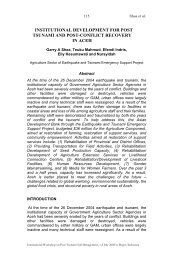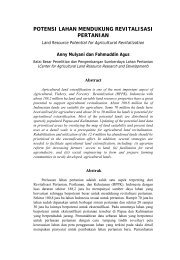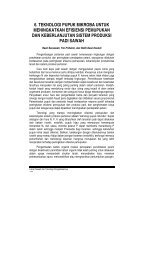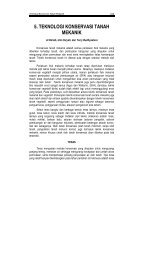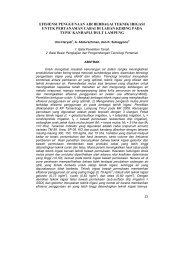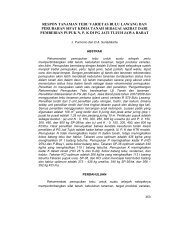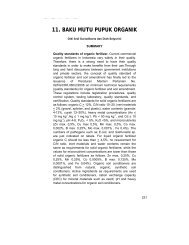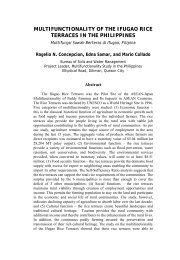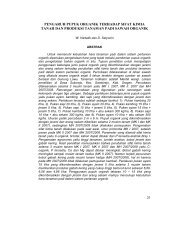Proceedings - Balai Penelitian Tanah
Proceedings - Balai Penelitian Tanah
Proceedings - Balai Penelitian Tanah
Create successful ePaper yourself
Turn your PDF publications into a flip-book with our unique Google optimized e-Paper software.
101<br />
Sembiring et al.<br />
Leaching, soil amendments and mulching, and fertilization are<br />
believed to be main components of land rehabilitation after tsunami.<br />
However, due to structural limitations of irrigation and drainage<br />
systems and the very complex problem associated with nutrient ions<br />
in tsunami-affected soil, both measures are not easy and required<br />
coordination and time. In Aceh Barat rehabilitation of agriculture has<br />
been particularly slow. The main limitations are the improvements<br />
required to irrigation and drainage systems which also affect the ability<br />
to improve soil nutrition (Sembiring and Gani 2007). Because of these<br />
limitations, the use of salt tolerant varieties is recommended to sustain<br />
rice productivity after tsunami in NAD.<br />
Symptoms of salt injury in the rice plant are stunted growth, reduced<br />
tillering, whitening of leaf tips and frequently, chlorotic parts on the<br />
leaves, and although rice is classified as a moderately tolerant crop,<br />
EC of 6-10 dS m -1 , salinity is associated with a 50% decrease in yield<br />
(Brinkman and Singh 1982). More over, Dobermann and Fairhurst<br />
(2000) noted that rice is relatively more tolerant of salinity at<br />
germination, but plants may become affected at transplanting, young<br />
seedling and flowering stages. According to Mengel and Kirkby<br />
(1979), the detrimental effects of salinity are also often dependent on<br />
the stage of plant growth. For many species the seedling stage is very<br />
sensitive to salinity. In most cereal crops grain yields are less affected<br />
than straw yields. For rice, however, the reverse is true, as this crop is<br />
particularly sensitive at the flowering and seed setting stage.<br />
SALINITY RESEARCH IN RESTORING RICE PRODUCTION IN<br />
NAD<br />
Soil fertility and other chemical, physical and biological changes<br />
related to salinity in tsunami-affected soils have manifested in<br />
disappointingly low yields in rice. In NAD province, rice harvested area<br />
at 2006 was 318,406 ha (315,324 ha or 99.0% comes from lowland),<br />
with production of 1,342,197 ton (1,335,354 ton or 99.5% comes from<br />
lowland). These figures were much lower to be compared to their<br />
values before tsunami. Table 2 shows that, two years after the<br />
tsunami, harvested area and production of lowland as the main<br />
system of rice production in NAD are 14% lower than those of 2004,<br />
as a consequence of earthquake and tsunami on December 2004.<br />
Due to the facts that saline soils have a complex problems, restoration<br />
of annual cropping especially rice cropping in tsunami-affected areas<br />
of Aceh Province, Indonesia is not an easy task. To improve the<br />
productivity of soil and rice crop, many factors arising after the<br />
tsunami must be considered. Research must be conducted to<br />
evaluate the real conditions of the tsunami-affected soils, in terms of<br />
rice cropping restoration after tsunami. There is a need to develop,<br />
International Workshop on Post Tsunami Soil Management, 1-2 July 2008 in Bogor, Indonesia



